Abstract
Despite extensive knowledge of the cutting methods described, no universal method has been developed so far for evaluating the technological quality of elements shaped by different cutting processes. The aim of the research described in this article was to fill this gap and to propose the author’s methodology for the assessment of the technological quality of the surface of X5CRNI18-10 steel shaped as a result of laser cutting and abrasive water jet cutting. A synthetic index of technological quality assessment of the surface after cutting CTQ (cutting technological quality) was proposed. Three groups of factors were taken into account in the assessment of technological quality of the surface after cutting: selected surface texture parameters (arithmetic mean deviation of the surface Sa and total height of the surface St), results of measurements of dimensional accuracy of cut elements (length deviation LD and width deviation WD) as well as indicators of surface morphology estimated on the basis of microscopic images of the surface after cutting (deformation intensity DI and identification of cutting zones ICZ). On the basis of CTQ values determined, the cutting results of both cutting methods were compared. The analyses presented in this paper proved that the CTQ index can be effectively used to compare the results of a cutting process conducted using different methods and under different conditions. The developed CTQ index is a universal valuation tool, allowing for quantitative evaluation of features related to the technological quality of cutting process results.
1. Introduction
The operation of cutting is carried out on a very wide range of materials: from those used in technology (metals, plastics), through mineral raw materials and derivatives (rocks, concrete), to natural biological materials (wood, organic tissue: bones, muscles). Diversity of cut materials is related to the fact that they are used in many spheres of human activity: industry, medicine, services, etc. The diversity of properties of materials to be cut makes it necessary to use different methods and ways of cutting [1,2,3,4].
Cutting of metals is an essential technological operation, from which the entire process of manufacturing in the machine industry usually begins. The development of cutting methods is a response to the increasing demands of new materials and the desire to increase the quality and efficiency of processes, ranging from straight cutting, through 2D cutting (in two dimensions) to 3D cutting (in three dimensions) [5,6]. One of the most important groups of cutting operations used in industry today is cutting with concentrated energy: water jet or abrasive water jet (AWJ), laser, plasma, ultrasonic in vacuum, oxy-gas and electron beam cutting [7,8,9,10,11,12].
This paper focuses on a comparative analysis of the results of laser cutting (laser cutting) and abrasive water jet. These techniques have become popular in the last decade in industrial practice, which is also due to their versatility resulting from the numerical control of the cutting head motion path.
A high-pressure water jet is ideal for cutting different hardnesses of steel, ensuring an even and accurate cut [13]. A variation of water jet cutting is hydro-jet technology, which uses a concentrated stream of energy in the form of a high-pressure water jet containing admixtures of abrasive grains [14]. The locally applied large amount of accumulated energy (in the form of accelerated abrasive grains) causes effective erosion of the material due to the detachment of its microparticles from the basic mass of workpiece. In this process, the kinetic energy of the abrasive grains is converted into deformation energy of the material in the machining zone.
The advantages of this technique include: obtaining high quality cutting surface, no structural changes of the material at the edges (no heat affected zone), no thermal deformation, high surface cleanliness, short process preparation and finishing times and high process efficiency. This method is particularly profitable for small and medium series of products [3,4,5,14,15]. Water jet cutting using a highly compressed water jet allows cutting almost all soft materials such as insulation materials, cardboard, etc. When cutting hard materials such as metal, glass, stone, etc., an abrasive material is added to the water stream increasing the cutting force and at the same time making it possible to cut materials up to 300 mm thick. The main disadvantages of this technique include the tendency to cause delamination or visible striations on the surfaces subjected to the jet.
Laser cutting is a process in which the energy of the photon in a form of laser beam, continuous or pulsed, causes the melting of the cut material in the cutting gap or the simultaneous melting and vaporization and burning of the cut material: metals, some ceramics or thermoplastics.
The advantages of laser cutting include [12,16,17]:
- Easy automation of the process and its high flexibility,
- Wide range of materials that can be cut (from very soft and brittle to very hard),
- High speed of the process,
- Narrow cutting gap and heat affected zone,
- The possibility of obtaining semi-products on dimension and contactless process resulting in the lack of tool wear,
- High degree of process automation,
- The possibility of obtaining high precision cutting,
- Control of energy supply to the material to be cut,
- High process flexibility when changing the production profile, as there is no need to change cutting tools.
The laser cutting process is suitable for cutting mild steel up to about 30 mm thick. Obtaining good results above the 25 mm barrier requires high quality of all elements such as material (steel to be laser cut), gas purity, nozzle condition and beam quality. The laser cutting process requires a simultaneous, coaxial flow of gas with the laser beam. This gas is called assist gas. Its task is to blow out the resulting products (liquid and vaporized material) from the cutting gap.
The common features of both characterized techniques—high cutting performance, wide range of cut materials and relatively high cutting precision [12,16]—mean that the two methods can often be used interchangeably. As a result, in order to make a rational decision on the choice of cutting method, it is necessary to estimate the technological quality of this operation [16].
The term quality can be defined as the relationship to certain characteristics of a product or service that affect the customer’s perception of it. It is the degree to which a set of inherent properties satisfies the requirements. The assessment of quality depends, among other things, on experience, knowledge, and demand for the product. This concept is subject to change as a result of human development, product and quality changes. Quality is significantly influenced by the level of awareness of employees, superiors and the degree of implementation of quality concepts within the company. The quality level is also determined by the customers. Quality is a multidimensional and interdisciplinary concept. Due to the place of shaping the quality in the manufacturing process, we can distinguish technological quality, functional quality and operational quality of the product. Technological quality changes with the use of successive technological operations from the pre-treatment operation, through the shaping treatment to the finishing treatment operation. In the case when the product has a complex structure, the assembly operations have a significant influence on the shaped quality, as a result of which the functional quality is obtained. On the other hand, after the product is handed over to the customer, the operating quality can be distinguished, which is greatly affected by the conditions and intensity of operation [1,14,15,16,17,18,19,20].
Despite extensive knowledge of the cutting methods described, no universal method has been developed so far for evaluating the technological quality of elements shaped by different cutting processes. The aim of the research described in this article was to fill this gap and to propose the author’s methodology for the assessment of the technological quality of the surface of X5CRNI18-10 steel shaped as a result of laser cutting and abrasive water jet cutting. A synthetic index of technological quality assessment of the surface after cutting CTQ was proposed. On the basis of CTQ values determined, the cutting results of both methods were compared, taking into account in the evaluation the parameters of the surface texture, deviations of dimensions of cut elements and the results of microscopic observations of deformation of the formed cut surface.
The aim of the study was to determine the most advantageous parameters of the investigated processes with respect to the assessed indices of technological quality assessment: dimensional accuracy, surface texture and results of microscopic observations of surface deformations after cutting of sheet made of X5CrNi18-10 steel [21,22,23]. In order to achieve the goal, 54 elements were cut out, 27 of them by laser and 27 by abrasive water jet, at variable set values of the considered cutting processes.
2. Materials and Methods
2.1. Experimental Positions and Workpiece
Laser cutting was carried out using numerically controlled Kimla FlashCUT LF 1530 6 kW (Kimla, Częstochowa, Poland)–Figure 1a–e [24]. Abrasive water jet cutting was carried out using a numerically controlled machine type PTV JETS 3.8/60 Basic (PTV, Hostivice, Czech Republic)–Figure 1f,g [25].
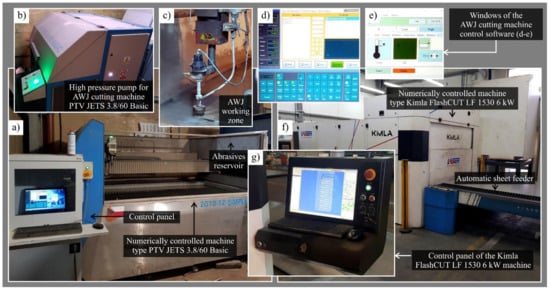
Figure 1.
Experimental positions used in the study: (a) general view of numerically controlled AWJ cutting machine Kimla FlashCUT LF 1530 6 kW (Kimla, Częstochowa, Poland); (b) view of the high pressure pump for AWJ cutting machine; (c) view of the AWJ cutting head; (d,e) windows of the AWJ cutting machine control software; (f) general view of numerically controlled laser cutting machine type PTV JETS 3.8/60 Basic (PTV, Hostivice, Czech Republic); (g) view of the laser cutting machine control panel.
The cutting process was carried out starting from determining the position and fixing of the input material, which was a sheet made of X5CrNi18-10 steel with dimensions of 1250 mm × 2500 mm, from which workpieces of a rectangular shape 100 mm × 30 mm were cut. Then, the cutting process was programmed according to the adopted experiment plan and given unique designations.
2.2. Measurement of Process Results
In the next stage of the study, we proceeded to measure the dimensional accuracy of the machined workpieces. For this purpose, QLR MMT digital micrometers (Qinghai Measuring and Cutting Tools Group Company, Xining, China) with measuring ranges of 25–50/0.001 mm and 50–100/0.001 mm were used. Length and width measurements were made by measuring the distance between the opposite edges of the cut objects at three locations. Measurements of the geometric structure of the surface formed in the laser and abrasive water jet cutting processes were also carried out using the multi-head measuring system Talysurf CLI 2000 from Taylor-Hobson Ltd. (Leicester, UK) [26]. In addition, microscopic images of the intersection surface were recorded by opto-digital microscopy using a digital measuring microscope type Dino-Lite Edge AM7915MZT from ANMO Electronics Co. (Taiwan, China) [27]. The observations were made in three areas of the surface: the upper (area I), middle (area II) and lower (area III); the designations refer to the direction of the energy stream.
2.3. Process Parameters
Table 1 presents a summary of the inputs (fixed and constant) and outputs of the study.

Table 1.
Specification of the input quantities (constant and variable) and output quantities of the tests conducted.
The selected range of changes of the adjustable parameters of both cutting processes (given in Table 1) resulted from the technological capabilities of the applied test stands. Both the plate thickness PT and the cutting parameters were selected in such a way that it was possible to effectively cut the workpiece material within the entire range of variation of cutting conditions.
2.4. Synthetic Index of Cutting Technological Quality CTQ
Three groups of factors were taken into account in the assessment of technological quality of the surface after cutting: selected surface texture parameters (arithmetic mean deviation of the surface Sa and total height of the surface St), results of measurements of dimensional accuracy of cut elements (length deviation LD and width deviation WD) as well as indicators of surface morphology estimated on the basis of microscopic images of the surface after cutting (deformation intensity DI and identification of cutting zones ICZ). An attempt was made to correlate these factors with a relation that would synthetically allow to assess the technological quality of the shaped surface. On the basis of these assumptions, a synthetic index for the assessment of the technological quality of the surface after cutting CTQ was developed, determined by the Equation (1):
where, subscripts n denote the values after normalization. Surface texture parameters (Sa and St) placed in the numerator of Equation (1) represent recognizable features of the solid (cut surface) associated with irregularities with relatively small vertex distances in 3D. Length and width deviation (LD and WD) are a measure of the difference of the actual dimension (determined by the measurement procedure) from the assumed (nominal) dimension, resulting from the values set in the cutting machine control program. On the other hand, deformation intensity DI and identification of cutting zones ICZ determine the features of surface morphology, which are characteristic for the cutting process. These features could be evaluated by qualitative analyses of microscopic images.
The construction of the proposed CTQ index (1) assumes dividing the numerator by 3 to obtain the resultant value from the range of 0–1 which, when multiplied by 100%, would allow expressing the technological quality of the evaluated surface after cutting with values from the range 0–100%. Due to the occurrence of negative values in the assessment of the dimensional accuracy, it was additionally necessary to express the product of the LD and WD deviations as an absolute value. As a result, CTQ index takes higher value for smaller sum of products, corresponding to smaller values of surface texture parameters, smaller dimensional deviations and smaller surface deformations after cutting.
3. Results and Discussion
The results of the conducted research were presented in four sections relating to surface texture analysis (Section 3.1), dimensional accuracy analysis (Section 3.2), microscopic image analysis (Section 3.3) and finally technological quality analysis (Section 3.4) workpieces machined using both cutting methods.
3.1. Surface Texture Analysis
The results of microtopography measurements of the cut surface showed significant differences between the values of selected surface texture parameters determined in the input and output areas of the abrasive water jet and the photon flux from the material. This proves reduced efficiency of water abrasive jet action as an erosive tool in shaping of the lower part of cutting zone. It is similar in the case of laser cutting, where the curvature of the laser beam in the lower part of the cut element distorts the cut edge from the middle of the plate thickness downwards. Therefore, it was decided that the measurements of microtopography of the cut surface will be made in the lower part of the cutting zone (at a distance of 1.0 mm from the bottom edge). The surface texture was recorded on each specimen at the bottom of the cutting zone with dimensions (x, y axis): 4.8 × 4.8 mm. During the measurement, 321 profiles (y-axis) were recorded. The distance between the profiles was 15 μm. On one profile 2401 points were registered (x-axis). The distance between profile points was 2 μm. Each measurement was performed in single-pass mode. The measurement time of one area was 4024 s. Data obtained during the measurements were analyzed using specialized software TalyMap Platinum 4.0 (Digital Surf, Besançon, France).
An overview of the surface microtopography obtained is shown in Figure 2 for the surface after laser cutting process and in Figure 3 for the surface after abrasive water jet cutting process.
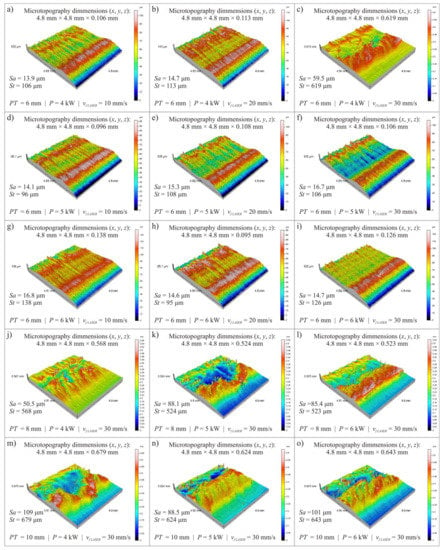
Figure 2.
An overview of selected microtopographies of cut surfaces of elements cut by laser cutting: (a–i) PT = 6 mm, P = 4, 5, 6 kW, vf LASER = 10, 20, 30 mm/s; (j–l) PT = 8 mm, P = 4, 5, 6 kW, vf LASER = 30 mm/s; (m–o) PT = 10 mm, P = 4, 5, 6 kW, vf LASER = 30 mm/s.
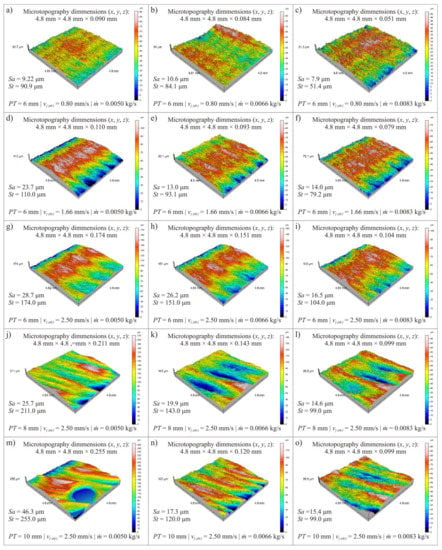
Figure 3.
An overview of selected microtopographies of cut surfaces of elements cut by abrasive water jet: (a–i) PT = 6 mm, vf AWJ = 0.80; 1.66; 2.5 mm/s, ṁ = 0.0050, 0.0066, 0.0083 kg/s; (j–l) PT = 8 mm, ṁ = 0.0050, 0.0066, 0.0083 kg/s, vf AWJ = 2.50 mm/s; (m–o) PT = 10 mm, ṁ = 0.005, 0.0066, 0.0083 kg/s, vf AWJ = 2.50 mm/s.
For each of the obtained surface microtopographies, the values of two surface texture parameters were determined:
- Sa–arithmetic mean deviation of the surface (μm),
- St–total height of the surface (μm).
Table 2 and Table 3 show the values of selected surface texture parameters after cutting the plate with thickness PT = 6, 8 and 10 mm for variable power P and cutting head feed rate vf LASER in laser cutting process as well as variable abrasive flow rate ṁ and cutting head feed rate vf AWJ in abrasive water jet cutting process.

Table 2.
Values of the Sa parameter of the surface after cutting for plate with thickness PT = 6, 8 and 10 mm and for variable power P and cutting head feed rate vf LASER in laser cutting process as well as for variable abrasive flow rate ṁ and cutting head feed rate vf AWJ in abrasive water jet cutting process.

Table 3.
Values of the St parameter of the surface after cutting for plate with thickness PT = 6, 8 and 10 mm and for variable power P and cutting head feed rate vf LASER in laser cutting process as well as for variable abrasive flow rate ṁ and cutting head feed rate vf AWJ in abrasive water jet cutting process.
The obtained results of surface texture measurements (Table 2 and Table 3) prove that the decrease in roughness amplitude parameter values, which can be interpreted as an increase in the quality of surfaces cut by the water-abrasive jet, is affected by decreasing the value of abrasive flow rate ṁ and increasing the cutting head feed speed vf AWJ. In the case of laser cutting an increase in the cutting head feed rate vf LASER affects increase of surface texture amplitude parameters (Sa and St) of the cut surface. In the conducted study, the effect of laser cutting power P was inconclusive.
The determined values of Sa and St parameters prove that plate thickness PT for both cutting methods significantly affects the quality of the surface after cutting. At the smallest plate thickness PT = 6 mm in the examined range, no significant traces of the effect of concentrated energy flux were observed, which became apparent when cutting plate thickness PT = 8 and 10 mm, which increased the values of surface texture parameters.
3.2. Dimensional Accuracy Analysis
The dimensional accuracy measurements performed in the described study allowed determination of the dimensional deviations of the workpieces after cutting. The largest positive deviation of length LD = 0.609 mm was observed in the element cut from a plate of thickness PT = 8 mm by laser with power P = 4 kW and cutting head feed rate vf LASER = 30 mm/s. On the other hand, the largest positive deviation of width WD = 0.563 mm was measured in the element cut out of the plate with thickness PT = 6 mm by the laser with power P = 4 kW and cutting head feed rate vf LASER = 30 mm/s. The largest negative value of the length deviation LD = −0.236 mm was observed in the element cut from a sheet of thickness PT = 10 mm by laser with power P = 6 kW and cutting head feed rate vf LASER = 10 mm/s. On the other hand, the largest negative deviation of the width WD = −0.237 mm was determined in the case of the workpiece cut from a plate of thickness PT = 10 mm by the laser with power P = 6 kW and cutting head feed rate vf LASER = 10 mm/s. The analysis of the presented results of dimensional accuracy measurements of cut out elements showed that the lowest dimensional accuracy was obtained in the process of laser cutting. It should be noted that this process was carried out with about 10 times higher feed rate values of the cutting head in comparison with the abrasive water jet cutting process.
The obtained measurements allowed determination of the mathematical models that informed the most favorable (in the assumed range of variability) cutting parameters, i.e., laser power P, feed rate of both cutting heads vf LASER and vf AWJ and abrasive flow rate ṁ. Multivariate correlation coefficients R were determined for the models to assess model adequacy. The models were specified as first-order exponential functions without interaction and plotted as shown in Figure 4 and Figure 5.
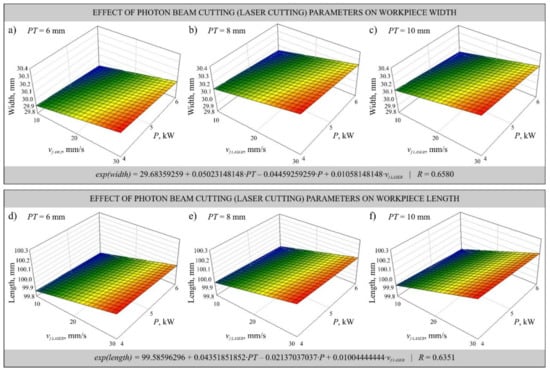
Figure 4.
Mathematical models developed using data from measurements of the width (a–c) and length (d–f) of elements cut by laser beam from plate of thickness PT = 6 mm (a,d), PT = 8 mm (b,e) and PT = 10 mm (c,f) as a function of changes in the laser head feed rate vf LASER and laser power P.
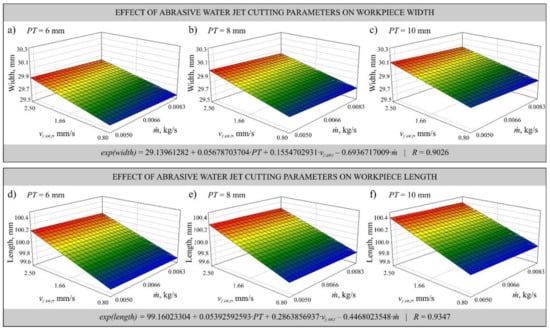
Figure 5.
Mathematical models developed using data from measurements of the width (a–c) and length (d–f) of elements cut by laser beam from plate of thickness PT = 6 mm (a,d), PT = 8 mm (b,e) and PT = 10 mm (c,f) as a function of changes in the AWJ head feed rate vf AWJ and abrasive flow rate ṁ.
The developed mathematical models describe the influence of changes of the laser head feed rate vf LASER and power P during laser cutting (Figure 4) as well as vf AWJ and abrasive flow rate ṁ (Figure 5) on the dimensional accuracy of the cut workpieces. In Figure 4, where the results are presented in the form of a graph of width w and length l, can be seen a slight effect of the laser power P on the dimensional accuracy, while the effect of the head feed rate vf LASER causes deviations of up to 0.2 mm, which is particularly evident in Figure 4b,c. The plate thickness PT also affects the dimensional deviation. The thicker the plate, the larger the positive deviation. The effect of varying cutting parameters causes the phenomenon of post-treatment marks, which can also adversely affect the measurements.
In abrasive water jet cutting the trends are similar, however, the deviation occurring is larger and amounts even to 0.3 mm for width w, which can be seen in Figure 5b, and 1.0 mm for length l, which can be seen in Figure 5d–f. The obtained measurement results showed that increasing the head feed rate vfAWJ causes deviation from perpendicularity of the surface formed in the abrasive water jet cutting process, which results in differences in the dimensions registered on the lower and upper parts of the cut workpieces. The abrasive flow rate ṁ slightly influenced the difference between the set dimension of the width w and the one actually cut out, which is visible in Figure 5a–c. However, no significant effect of abrasive flow rate ṁ on the deviation of length l was observed. This can be explained by the fact that the abrasive is only a factor that improves the cutting process, causing more degradation of the cut material, but not significantly affecting the dimension of the cut workpiece. Consequently, the inclination of the cutting plane is reduced.
3.3. Microscopic Image Analysis
Figure 6 shows examples of microscopic images of surfaces after laser cutting and Figure 7 shows examples of microscopic images of surfaces after abrasive water jet cutting.
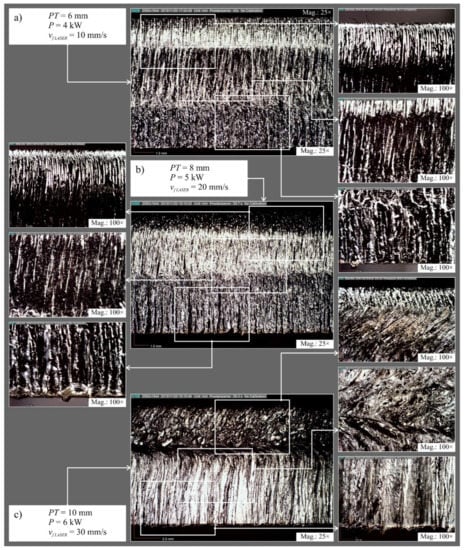
Figure 6.
Examples of microscopic images of surfaces after laser cutting: (a) PT = 6 mm, P = 4 kW, vf LASER = 10 mm/s; (b) PT = 8 mm, P = 5 kW, vf LASER = 20 mm/s; (c) PT = 10 mm, P = 6 kW, vf LASER = 30 mm/s.
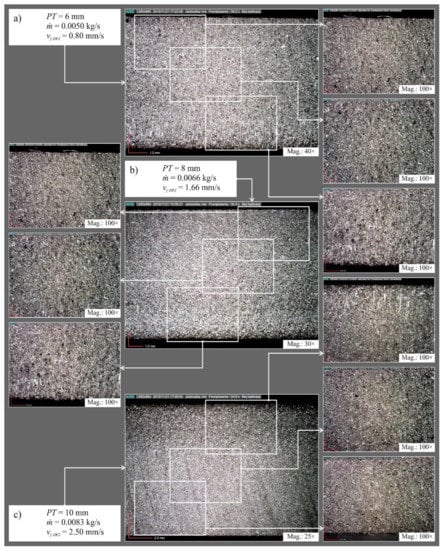
Figure 7.
Examples of microscopic images of surfaces after abrasive water jet cutting: (a) PT = 6 mm, ṁ = 0.0050 kg/s, vf AWJ = 0.80 mm/s; (b) PT = 8 mm, ṁ = 0.0066 kg/s, vf AWJ = 1.66 mm/s; (c) PT = 10 mm, ṁ = 0.0083 kg/s, vf AWJ = 2.50 mm/s.
Observation of the microscopic images allowed identification of the defects in the cut surface and to observe the quality zones present in both cutting methods. The occurrence of mechanical erosion of abrasive grains in abrasive water jet cutting noticeably affects the degradation of the cut surface. Increasing the plate thickness from PT = 6 to 8 mm and then to 10 mm resulted in an increase in the number of surface deformations observed by microscopy technique in both cutting methods. On the other hand, at the smallest value of abrasive flow rate ṁ on the surface after abrasive water jet cutting, clear deformation traces were recorded for plate thicknesses PT = 8 and 10 mm. A similar situation was observed on the surface after cutting elements shaped with the average and with the highest head feed ratio vf AWJ = 1.66 and 2.50 mm/s, respectively.
The surface after laser cutting was characterized by significantly higher deformation intensity compared to the surface after abrasive water jet cutting. Increasing the value of laser power P and the feed rate of the head vf LASER had an adverse effect on the shape of the surface after cutting. This showed a clear division into three zones of the cut surface. In zone one, the trace of a precise cut perpendicular to the surface of the plate is noticeable. Zone two is characterized by a wavier surface, which is the result of energy being stored here. In zone three, the surface quality is strongly affected by the molten material ejected by the associated gas in the upper zone.
3.4. Technological Quality Analysis
Table 4 and Table 5 present a summary of the values of the factors (before and after normalization) enabling determination of the synthetic index of technological surface quality assessment, respectively after laser cutting CTQLASER (Table 4) and after abrasive water jet cutting CTQAWJ (Table 5). The variability of the CTQ index values obtained is also presented in the form of graphs in Figure 8.

Table 4.
List of the values of factors (before and after normalization) enabling the determination of cutting technological quality index after laser cutting CTQLASER (subscripts n denote values after normalization).

Table 5.
List of the values of factors (before and after normalization) enabling the determination of cutting technological quality index after AWJ cutting CTQAWJ (subscripts n denote values after normalization).
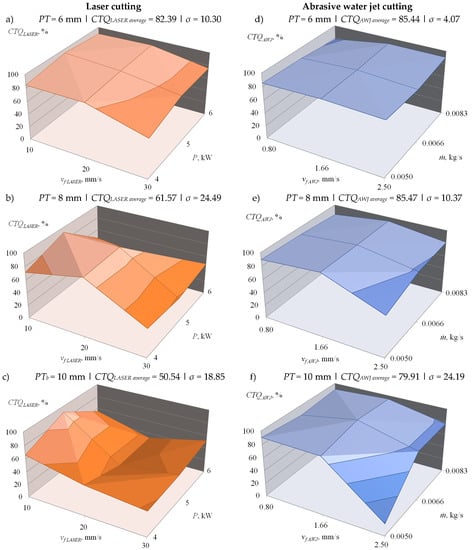
Figure 8.
Changes in CTQ values of the surface after cutting plates with thicknesses PT of 6 mm (a,d), 8 mm (b,e) and 10 mm (c,f) depending on the variable power P and cutting head feed rate vf LASER in laser cutting process (a–c) as well as variable abrasive flow rate ṁ cutting head feed rate vf AWJ in abrasive water jet cutting process (d–f) (σ–standard deviation).
Analysis of CTQ index values (Table 4 and Table 5, Figure 8) allowed determination of the most advantageous parameters of both considered cutting processes from the point of view of technological quality assessment of workpieces after cutting. The evaluation took into account the selected surface texture parameters, deviations of dimensions of cut elements and microscopic observations of shaped cut surface deformation. As a result, it was determined that for the considered range of variability of the technological parameters of the laser cutting process, for particular plate thicknesses, the following parametric values can be regarded as the most advantageous:
- For sheet thickness PT = 6 mm: laser power P = 5 kW and working head feed rate vf LASER = 10 mm/s (CTQLASER = 93.85%),
- For sheet thickness PT = 8 mm: laser power P = 5 kW and working head feed rate vf LASER = 10 mm/s (CTQLASER = 92.31%),
- For sheet thickness PT = 10 mm: laser power P = 5 kW and working head feed rate vf LASER = 10 mm/s (CTQLASER = 90.90%).
However, for the abrasive water jet cutting process, the following parameter values were selected as the most favorable for the conditions under consideration:
- For sheet thickness PT = 6 mm: abrasive flow rate ṁ = 0.0083 kg/s and working head feed rate vf AWJ = 1.66 mm/s (CTQAWJ = 90.68%),
- For sheet thickness PT = 8 mm: abrasive flow rate ṁ = 0.0050 kg/s and working head feed rate vf AWJ = 1.66 mm/s (CTQAWJ = 96.30%),
- For sheet thickness PT = 10 mm: abrasive flow rate ṁ = 0.0066 kg/s and working head feed rate vf AWJ = 1.66 mm/s (CTQAWJ = 99.41%).
On the example of analysis of the process of laser cutting and abrasive water jet cutting of stainless steel X5CRNI18-10 it was proved that the proposed synthetic index of technological quality assessment of the surface after cutting CTQ can be effectively used to determine the most favorable parameters of the cutting process. The design of the CTQ index allows taking into account other features of the analyzed surface and expanding their number, e.g., by adding parameters for evaluating the surface layer structure, surface microhardness, etc. The presented broad set of analyses showed that the developed CTQ index is a universal valuation tool, allowing for quantitative evaluation of features related to the technological quality of cutting process results.
4. Conclusions
The analyses presented in this paper in the scope of technological quality assessment of the workpieces after laser cutting and abrasive water jet cutting made it possible to formulate the following conclusions.
- The obtained results of surface texture measurements of surfaces cut by the water-abrasive jet prove that the decrease in roughness amplitude parameter values (Sa and St) is affected by decreasing the value of abrasive flow rate ṁ and increasing the cutting head feed speed vf AWJ.
- In the laser cutting process an increase in the cutting head feed rate vf LASER affects increase of parameters Sa and St of the cut surface, at the same time the effect of laser cutting power P was inconclusive in this study.
- For both analyzed cutting methods plate thickness PT significantly affects the quality of the surface after cutting–at the smallest plate thickness PT = 6 mm in the examined range, no significant traces of the effect of concentrated energy flux were observed, which became apparent when cutting plate thickness PT = 8 and 10 mm.
- In the laser cutting process the dimensional accuracy of the cut workpieces affects mostly the head feed rate vf LASER (high feed rate causes deviations of up to 0.2 mm) and plate thickness (the thicker the plate, the larger the positive deviation).
- In abrasive water jet cutting trends are similar, however, the dimensional deviation occurring is larger and amounts even to 0.3 mm. Additionally it was noted that increasing the head feed rate vf AWJ causes deviation from perpendicularity of the surface formed. No significant effect of abrasive flow rate ṁ on the dimensional deviation was observed.
- Observation of microscopic images showed that increasing the plate thickness from PT = 6 to 8 mm and then to 10 mm resulted in an increase in the number of surface deformations in both cutting methods.
- The surface after laser cutting was characterized by significantly higher deformation intensity (with visible division into three zones of the cut surface) compared to the surface after abrasive water jet cutting.
- The analysis showed that the most favorable (highest) CTQ value of the entire set of analyzed results (CTQAWJ = 99.41%) was obtained for the abrasive water jet cutting process with sheet thickness PT = 10 mm, abrasive flow rate ṁ = 0.0066 kg/s and working head feed rate vf AWJ = 1.66 mm/s.
- The most favorable value of CTQ index for laser cutting process (CTQLASER = 93.85%) was obtained for sheet thickness PT = 6 mm, laser power P = 5 kW and working head feed rate vf LASER = 10 mm/s.
- The relative (percentage) form of the CTQ index means that it can be used to compare the results of a cutting process conducted using different methods and under different conditions.
Author Contributions
Conceptualization, K.N., M.R. and C.Ł.; methodology, K.N. and M.R.; software, M.R., M.S. and W.Z.; validation, K.N. and C.Ł.; formal analysis, M.R. and D.Y.P.; investigation, M.R., M.S. and W.Z.; resources, K.N., M.R., M.S. and W.Z.; data curation, M.R., M.S. and W.Z.; writing—original draft preparation, M.R and K.N.; writing—review and editing, C.Ł. and D.Y.P.; visualization, M.R.; supervision, K.N.; project administration, K.N. All authors have read and agreed to the published version of the manuscript.
Funding
This research received no external funding.
Institutional Review Board Statement
Not applicable.
Informed Consent Statement
Not applicable.
Conflicts of Interest
The authors declare no conflict of interest.
Nomenclature
| AWJ | Abrasive water jet |
| CTQ | Cutting technological quality, – |
| CTQLASER | Laser cutting technological quality, – |
| CTQAWJ | Abrasive water jet cutting technological quality, – |
| DI | Deformation intensity, – |
| DIn | Normalized deformation intensity, – |
| ICZ | Identification of cutting zones, – |
| ICZn | Normalized identification of cutting zones, – |
| l | Workpiece length, mm |
| LD | Length deviation, mm |
| LDn | Normalized length deviation, mm |
| ṁ | Abrasive flow rate, kg/s |
| P | Laser power, kW |
| PT | Plate thickness, mm |
| R | Multivariate correlation coefficient of mathematical model, – |
| Sa | Arithmetic mean deviation of the surface, μm |
| San | Normalized arithmetic mean deviation of the surface, μm |
| St | Total height of the surface, μm |
| Stn | Normalized total height of the surface, μm |
| vf LASER | Laser head feed rate, mm/s |
| vf AWJ | Abrasive water jet head feed rate, mm/s |
| w | Workpiece width, mm |
| WD | Width deviation, mm |
| WDn | Normalized width deviation, mm |
References
- Rao, P.N. Manufacturing Technology: Metal Cutting and Machine Tools; Tata McGraw-Hill Education: Kala Nilayam, India, 2013. [Google Scholar]
- Khan, M.A.; Soni, H.; Mashinini, P.M.; Uthayakumar, U. Abrasive water jet cutting process form machining metals and composites for engineering applications: A review. Eng. Res. Express 2021, 3, 022004. [Google Scholar] [CrossRef]
- Llanto, J.; Tolouei-Rad, M.; Vafadar, A.; Aamir, M. Recent Progress Trend on Abrasive Waterjet Cutting of Metallic Materials: A Review. Appl. Sci. 2021, 11, 3344. [Google Scholar] [CrossRef]
- Kuttan, A.A.; Rajesh, R.; Anand, M.D. Abrasive water jet machining techniques and parameters: A state of the art, open issue challenges and research directions. J. Braz. Soc. Mech. Sci. Eng. 2021, 43, 1–14. [Google Scholar] [CrossRef]
- Klichová, D. Advances in Water Jetting: Selected Papers from the International Conference on Water Jet 2019—Research, Development, Applications; Springer Nature: Basingstoke, UK, 2020. [Google Scholar]
- Zhang, S.; Ji, L.; Wu, Y.; Chen, M.; Zhou, W. Exploring a new method to obtain the 3D abrasive water jet profile. Int. J. Adv. Manuf. Technol. 2020, 107, 4797–4809. [Google Scholar] [CrossRef]
- Radu, M.C.; Schnakovszky, C.; Herghelegiu, E.; Tampu, N.C.; Zichil, V. Comparative analysis of the processing accuracy of high strength metal sheets by AWJ, laser and plasma. IOP Conf. Ser. Mater. Sci. Eng. 2016, 145, 022034. [Google Scholar] [CrossRef] [Green Version]
- Radu, C.; Herghelegiu, E.; Schnakovszky, C. Comparative study on the effects of three unconventional cutting technologies on cut surface quality. Indian J. Eng. Mater. Sci. 2015, 22, 127–132. [Google Scholar]
- Tezuka, M.; Nakamura, Y.; Iwai, H.; Sano, K.; Fukui, Y. The development of thermal and mechanical cutting technology for the dismantlement of the internal core of Fukushima Daiichi NPS. J. Nucl. Sci. Technol. 2014, 51, 1054–1058. [Google Scholar] [CrossRef] [Green Version]
- Dahil, L.; Dahil, I.; Karabulut, A. Comparison of advanced cutting techniques on hardox 500 steel material and the effect of structural properties of the material. Metalurgija 2014, 53, 291–294. [Google Scholar]
- Akkurt, A. Experimental investigation of the surface properties obtained by cutting brass-353 (α + β) with an abrasive water jet and other cutting methods. Mater. Tehnol. 2014, 48, 725–734. [Google Scholar]
- Peržel, V.; Hloch, S.; Tozan, H.; Yagimli, M.; Hreha, P. Comparative analysis of abrasive waterjet (AWJ) technology with selected unconventional manufacturing processes. Int. J. Phys. Sci. 2011, 6, 5587–5593. [Google Scholar]
- Kechagias, J.; Petropoulos, G.; Vaxevanidis, N. Application of Taguchi design for quality characterization of abrasive water jet machining of TRIP sheet steels. Int. J. Adv. Manuf. Technol. 2011, 62, 635–643. [Google Scholar] [CrossRef]
- Momber, A.W.; Kovacevic, R. Principles of Abrasive Water Jet Machining; Springer Science and Business Media LLC: Berlin, Germany, 1998. [Google Scholar]
- Sutowska, M.; Kapłonek, W.; Pimenov, D.Y.; Gupta, M.K.; Mia, M.; Sharma, S. Influence of Variable Radius of Cutting Head Trajectory on Quality of Cutting Kerf in the Abrasive Water Jet Process for Soda–Lime Glass. Materials 2020, 13, 4277. [Google Scholar] [CrossRef]
- Zheng, H.Y.; Han, Z.Z.; Chen, Z.D.; Chen, W.L.; Yeo, S. Quality and Cost Comparisons between Laser and Waterjet Cutting. J. Mater. Process. Technol. 1996, 62, 294–298. [Google Scholar] [CrossRef]
- Ninikas, K.; Kechagias, J.; Salonitis, K. The Impact of Process Parameters on Surface Roughness and Dimensional Accuracy during CO2 Laser Cutting of PMMA Thin Sheets. J. Manuf. Mater. Process. 2021, 5, 74. [Google Scholar] [CrossRef]
- Kudelski, R.; Zagórski, K.; Cieślik, J. Dependency of the technological quality of elements made from multi layered materials on their shape in the water jet machining method. In Proceedings of the 3rd National Conference on Current and Emerging Process Technologies—Concept 2020; AIP Publishing: Melville, NY, USA, 2020; Volume 2239, p. 020024. [Google Scholar]
- Vartanov, M.V.; Vlasov, A.S. Technological quality maintenance of finishing robotic machining in mechanical engineering. IOP Conf. Series: Mater. Sci. Eng. 2020, 971, 042084. [Google Scholar] [CrossRef]
- Kmec, J.; Gombár, M.; Harničárová, M.; Valíček, J.; Kušnerová, M.; Kříž, J.; Kadnár, M.; Karková, M.; Vagaská, A. The Predictive Model of Surface Texture Generated by Abrasive Water Jet for Austenitic Steels. Appl. Sci. 2020, 10, 3159. [Google Scholar] [CrossRef]
- Bringas, J.E. Handbook of Comparative World Steel Standards; ASTM International: West Conshohocken, PA, USA, 2004. [Google Scholar]
- Kazantseva, N.V.; Stepanova, N.N.; Rigmant, M.B. Superalloys: Analysis and Control of Failure Process; CRC Press: Boca Raton, FL, USA, 2018. [Google Scholar]
- Romanowski, M.; Nadolny, K. Surface texture analysis of the X5CrNi18-10 steel after cutting with abrasive water jet and photon beam (laser). J. Mech. Energy Eng. 2021, 4, 365–374. [Google Scholar] [CrossRef]
- Product Website. Available online: https://kimla.pl/en/machines/laser-fiber-cutter (accessed on 21 July 2021).
- Product Website. Available online: https://ptv.com.pl/produkty/wysokocisnieniowe-pompy/ptv-jets-38-60-cbasic/ (accessed on 21 July 2021).
- Kapłonek, W.; Nadolny, K.; Valíček, J.; Zeleňák, M. A non-contact laser method based on the imaging and analysis of scattered light used for assessment of the surface imperfections. Meas. Autom. Monit. 2012, 58, 554–558. [Google Scholar]
- Product Website. Available online: https://www.dino-lite.eu/index.php/en/component/k2/item/3088-am7915mzt (accessed on 21 July 2021).
Publisher’s Note: MDPI stays neutral with regard to jurisdictional claims in published maps and institutional affiliations. |
© 2021 by the authors. Licensee MDPI, Basel, Switzerland. This article is an open access article distributed under the terms and conditions of the Creative Commons Attribution (CC BY) license (https://creativecommons.org/licenses/by/4.0/).